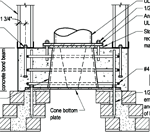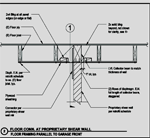As a part of preparing for the next earthquake, do a what if? survey of your home.
This list is comprehensive but not complete; each household will have unique and even unanticipated issues that will need to be addressed as part of planning. As we say in Community Emergency Response Team (CERT) training: adapt, improvise, overcome.
Also, some items on the checklist may not be applicable to a given household.
Renters may need to consult owners before doing some of this.
And this all applies to where you work. Are those heavy shelves bolted to the wall, or could they come down in a quake and block the exit door from your workspace?
It’s time for a tour of the crawl space.
Check under the house for pipes left unsupported for too long a span. Have a plumber check for the integrity of older pipes.
If your home was built before 1935 – or- in some areas, before 1960 -or- IF the contractor didn’t care enough to do a good job or employed cost-cutting measures like not using enough nails, (which it turns out is quite frequent!) it may not be properly bolted to its foundation. Various studies have shown that even new homes may have missing or not secured foundation bolts. (Generally, bolts from the wooden mudsill to the concrete foundation should be no more than 6 feet apart in single story homes, 4 feet apart in multi-story.)
If you have a short wall connecting the foundation to the floor, a cripple wall, it is often not strong enough to survive the force of even a moderate earthquake. Reinforcing it with plywood is very cost effective.
Dry rot due to water damage or damaged wood from insect damage may need to be replaced. If your concrete foundation has cracks wider than 1/8 inch, a mottled, ‘honeycomb’ look, or if the concrete chips or flakes when you poke it with a screwdriver, you may need to consult an engineer to design a solution.
Walk around the interior and exterior and imagine a lot of shaking- then prioritize which projects to do first.
Move the heads of beds (and pet cages) away from windows that can shatter, and move heavy
mirrors and paintings from above beds. Have only soft art, such as tapestries, over beds or sofas.
Is that bunk bed secure?
Where else will broken glass land? If a window shatters over the kitchen counter you won’t be able to find all the glass shards in food that was sitting on the counter, so throw it all out. A mirror that breaks over the bathroom sink will put tiny pieces of glass into the bar of soap and you could have very cut hands as a result when you wash your hands. (This happened to a woman in a Coalinga quake). Likewise a toothbrush sitting out could be dangerous.
Brace bookcases and dish hutches to STUDS in walls, even if they won’t fall on you; they could
kill pets. Use screws, not nails. Flexible-mount fasteners will allow some movement, putting less strain on the studs. Don’t attach them only into sheetrock (drywall). (Four people DIED in the Northridge quake because of damage to building contents such as toppling bookcases). Filing cabinet drawers become projectiles in a quake. If you have a lot of furniture to attach to the walls, and it seems like an overwhelming project, start with bookcases, etc. that could block exits from the house when they topple, or could land on places where people sit often, like couches, beds, dining table area.
how to anchor:
https://homeguides.sfgate.com/anchor-large-bookcase-damaging-bookcase-30016.html

55% of injuries in the Northridge quake were caused by falling objects, such as TVs, pictures and heavy light fixtures – – – mostly preventable injuries.
You need childproof-type latches on cupboard doors and railings on garage shelves. Move
heavier items to lower shelves.
Move heavy items on shelves in the garage away from over the car where they will damage it OR block your use of it.
Anything flammable, including propane tanks for camping, should not be in the house. If you can find outside storage, such as in a shed, you will be even safer from flammables than if they are stored in the garage. Put them on a low shelf.
Pesticides, pool cleaners, etc. also should not be IN your house. Store all cleaners, chemicals with hazards in mind. They should all be on a floor level shelf so any earthquake shaking motion will affect them less. The shelf, cabinet or shelves should be anchored to the wall with some type of restraint across the front of the shelf to prevent bottles from falling. Read hazardous household chemical mixtures
You won’t have to replace pictures if they are secured to walls with eyebolts and hollow wall
anchors (for light weight items) or eye screwed to a wall stud for heavier items. Or hang them from closed hooks. Velcro on bottom corners will also help prevent movement.
‘Museum Wax,’ or other earthquake putty/quake gel (sold at hardware stores and the like) can secure art pieces, etc. to table tops, mantles.
Move heavy things to lower shelves when possible. Secure computers, etc. to desks with flexible nylon safety straps or industrial strength velcro or high friction skids.
Don’t put pet cages, sofas or beds where things from shelves
can fall on them.
Hanging plants should be in lightweight pots. Will they, or other decorations, swing into a
window and break it?
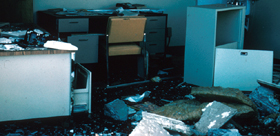
Is the ceiling system suspended or unbraced? Are there lights or ventilation grills built into a suspended ceiling?
At least remove or lock refrigerator rollers, but it’s better to secure the fridge to wall STUDS using earthquake appliance straps.
Does the birdcage have a tight, secure latch and do you always use it?
Is the swamp cooler really attached properly?
Roof top air conditioners may need extra bracing.
According to the ABAG website:
“In the 1994 Northridge earthquake, approximately 60,000 masonry chimneys were destroyed or damaged beyond repair. Most chimneys tend to break at the roofline and fall away from the home. However, some chimneys can fall into the home, causing serious injury and death.”
If you have an unreinforced masonry chimney the best thing to do is to have it removed and replaced with a metal flue with a wood frame or a reinforced portion that is tied to the roof. In the meantime you might want layers of plywood in the attic over the ceiling framing to protect people and the house interior.
After the quake, a cracked or otherwise seemingly slightly damaged chimney needs to be inspected by a qualified professional before the woodstove or fireplace are used.
A boy was gravely injured during a slumber party when bricks from the fireplace front inside of the house fell on him.
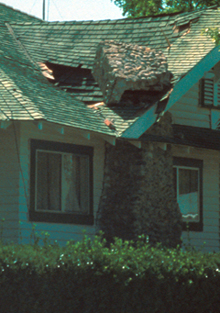
Will bricks fall from the chimney outside on the dog, or can you fence him away from that area? Locate the picnic table / barbeque /play area away from where the chimney will fall. Don’t park the car where the chimney will fall on it.
Where will the chimney at the next door house fall? Into your yard?
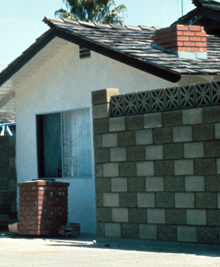
Strap the water heater(s) to the wall(s) at studs. Use at least two straps. Check to see that you have a flexible connection from the hot water heater, stove, etc. to the gas line. It should be longer than necessary to allow for movement during the quake.
With these flexible connectors you can include a excess-flow gas-shutoff valve to stop flow in case of a big leak.
Ceiling lights and fans can be very heavy and present a significant safety hazard. These should
be additionally supported with a cable bolted to the ceiling joist. The cable should have enough
slack to allow it to sway.
Consider window solar/safety film. It can save you from flying glass shards and can save enough energy to pay for the cost of the film. Making it a habit to close blinds, draw drapes and pull down or close shades can help.
Consider an uninterruptible power supply for your computer so you’ll have the time to properly save work, or with a more expensive system, to finish or even print documents. You do keep files backed up regularly and turn off devices when they’re not being used, don’t you?
Little night lights that plug into outlets and go on for awhile when the power goes off are cheap.
Simple, relatively inexpensive solar lights, from path lights to motion activated porch lights, will
make your home less inviting to burglars during any power outage.
If you have an electric garage door opener, find out where the manual release lever is located
and learn how to operate it. During a power outage, electronic garage door openers will not operate!
If through the garage is the only exit from the house and you can’t open the garage door, you can be stuck.
If your freezer is only partially full, put in plastic bottles of water so it will hold food cold enough longer. (Add only one at a time so you don’t thaw the food already in the freezer).
If you live where a dam break or ?? could flood your home, consult a professional about raising your furnace, water heater and electric panel.
If you live in an area with a chance of damage from liquefaction – from ancient stream beds under your property, like the ones under San Jose airport runways, or from being built on hydraulic fill over bay mud, like the Oakland International Airport, consider installing an earthquake gas shut-off valve that will automatically shut off your gas service during a quake that measures 5.3 to 5.4 or greater at your home’s location. All newly constructed homes and businesses in Los Angeles must have these. (Drawback: a heavy truck passing by could trigger a shut-off.)
(see maps at ABAG website https://abag.ca.gov/our-work/resilience
Start with — HAZARD VIEWER but note that it has said: “Note that due to the complexity of the maps, each layer may take some time to load.”
The power company may not know branches need to be cleared from local power lines unless you tell them.
The fire department won’t know about hazardous conditions (including excessive dry brush/grass) in the neighborhood unless someone reports them.
Public safety personnel can’t find your home in a hurry if you don’t have the street number, in large numerals, displayed at the front of the house and on any long driveways or other entrances. Reflective numbers are best.
If you are the least bit uncertain if your home, chimney, front porch, or ??? needs extra bracing
or whether your home is properly bolted to the foundation, consult an engineer for a bid.
When to call an engineer- not just a contractor– about your home. (from the ABAG website)
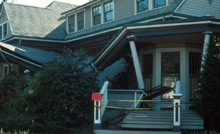
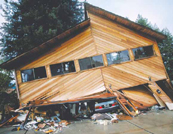
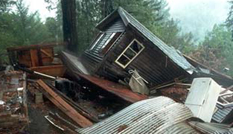
· your home has two or more stories
· part of your home is supported by posts, not a wall
· your foundation is brick or is “weak”
· your home has an unusual shape, is very long and narrow, or is shaped like an “L”
· your home is on a steep hill
· your home has a two-car or larger garage with rooms above it, or is a “split-level”
· your home has a porch that is recessed under a second story
· your home is almost touching an adjacent home
In UCLA magazine we read:
“In 1994, a 6.7 magnitude earthquake that struck in the San Fernando Valley destroyed or significantly damaged an estimated 90,000 buildings. Of the approximately 60 people killed, 33 were in buildings that fell. The most common—small apartment buildings perched over space largely left empty for parking. With enough shaking, the apartments come crashing down on the mostly hollow space below. . .
. . . Soft story buildings were not designed to resist earthquake forces specified in the current building code and should be evaluated for retrofit. A number of these buildings collapsed during the 1994 Northridge earthquake.”
In the 1964 Alaska earthquake multistory buildings that were up to code (some supposedly designed for earthquakes) were heavily damaged, especially upper stories falling in to the “soft” lower story.
Of about 2,000 buildings Santa Monica considered in 2017 for mandatory retrofitting, about 1,700 of them were, according to the LA Times, “wooden apartment buildings with carports on the ground story and held up by flimsy columns that might snap in an earthquake. Known as soft-story buildings, one such complex collapsed in the 1994 Northridge earthquake, killing 16 people on the ground floor in the predawn darkness.”
___________________________________________
Did you remodel? then you might also want to contact an engineer…
Small changes, like replacing a window with a sliding door, (installation done properly) might have little effect on the earthquake resistance, but adding large areas of glass or removing interior walls could weaken your house.
Putting in a heavier roof, such as replacing wood or composition shingles with a tile or slate roof, means you may need extra bracing. Loose tiles could fall in a quake.
below: unreinforced brick masonry vs truck in Los Gatos and fallen unreinforced brick facade vs bicycles, both from the Loma Prieta quake
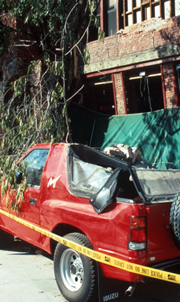

______________________________________________
And read more at a FEMA file about retrofitting homes:
which includes many drawings:
and lists, in part:
“ Common Vulnerabilities
. . .items listed range in level of risk and effort and cost required to mitigate the
risk. . .
“Water heaters. Water heaters are a very common source of damage,
ranging from fire started by damaged gas lines, to water damage that
occurs when the tank fractures. Bracing of water heaters is relatively
easy and inexpensive, with premanufactured seismic strapping kits
available at many local hardware stores.
Contents. Furniture and other home contents can fall during an
earthquake, potentially injuring occupants. Practical and inexpensive
approaches are available for anchoring contents to walls and the floor.
Alternatively, some contents might be moved away from commonly used
areas, paths of travel, and particularly exits. Priority should be given to
taller and heavier contents that provide higher seismic hazard to
occupants.
Decks and exit porches. Decks and porches are often only nominally
fastened to the dwelling that is supporting them. Under moderate to high
earthquake shaking, they can pull away and collapse. Practical methods
are available to better anchor decks and porches to the dwelling, or to
provide bracing between the deck or porch and the supporting
foundation
Roof tiles. Clay tiles can become dislodged from roofs and pose a falling
hazard, particularly when not installed and fastened per recent building
code requirements. While the short-term risk can be addressed by
keeping clear of the edge of the roof, it is also possible to better anchor
the roof tiles to resist falling.
Wood burning stoves and propane tanks. When not anchored or
restrained, wood burning stoves and propane tanks can shift or topple in
an earthquake, causing damage and potential fire hazards.
Overhead windows and skylights. Where large areas of glass (or mirror)
occur, there is higher likelihood of breakage. Measures available to
mitigate risk include applying films to glazing. Films will not reduce
breakage, but could help to reduce spread of broken glass . . .”
Below a USGS photo from the Loma Prieta quake
“An automobile lies crushed under the third story of this apartment building in the Marina District. The ground levels are no longer visible because of structural failure and sinking due to liquefaction.”

______________________________________________
A family (and babysitters, caregivers, overnight guests) disaster plan is at:
______________________________________________
You can find detailed maps (with zoom in capability) of potential road closures, risk of liqufaction and flooding, such as this map of potential Bay Area road closures after a San Andreas fault 7.2 quake,

at the ABAG link at: Earthquake information sources
fastest, easiest, cheapest earthquake preparedness projects
Helping Children Cope With Disaster
Store water for after an earthquake
Babysitter Consent and Contact Form
hazardous household chemical mixtures
The author of this webpage, (written as a homework reading assignment for my students), does not give any warranty, expressed or implied, nor assume any legal liability or responsibility for the accuracy, completeness, or usefulness of any information, product, or process included in this website or at websites linked to or from it. Users of information from this website assume all liability arising from such use.
